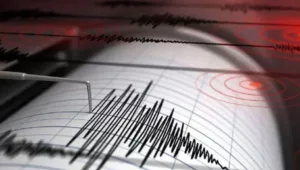A powerful earthquake with a magnitude of 6.1 hit northern Nepal, near Kathmandu, on Friday, according to the National Earthquake Monitoring and Research Centre of Nepal. The quake’s epicentre was located near Bhairab Kunda in the Sindhupalchok District, a region still recovering from the devastating 2015 earthquake.
Key Details of the Earthquake
- Magnitude: Nepal’s National Earthquake Monitoring and Research Centre reported a magnitude of 6.1, while the German Research Centre for Geosciences recorded it at 5.6.
- Depth: The quake occurred at a depth of 10 kilometres (6.21 miles).
- Location: The epicentre was near Bhairab Kunda in the Sindhupalchok District, approximately 75 kilometres northeast of Kathmandu.
Immediate Impact and Response
As of now, there have been no reports of damage or casualties. However, the quake caused significant panic among residents, many of whom were shaken awake by the tremors.
Ganesh Nepali, a senior official in the Sindhupalchok District, shared his experience with Reuters:
“It shook us from our sleep strongly. We rushed out of our homes. People have now returned to their homes. We have not received any reports of damage or injuries so far.”
The lack of immediate damage is a relief, especially in a region still rebuilding from the 2015 earthquake that claimed nearly 9,000 lives.
Why This Earthquake Matters
Nepal is located in a seismically active zone, making it prone to earthquakes. The Himalayan region, where Nepal lies, is formed by the collision of the Indian and Eurasian tectonic plates, resulting in frequent seismic activity.
While this earthquake did not cause significant damage, it serves as a reminder of the importance of earthquake preparedness and resilient infrastructure in vulnerable areas.
Key Takeaways
- A 6.1-magnitude earthquake struck northern Nepal near Kathmandu.
- The epicentre was in the Sindhupalchok District, a region still recovering from the 2015 quake.
- There have been no reports of damage or casualties so far.
- The event highlights the need for earthquake preparedness in seismically active regions.
This earthquake underscores the ongoing seismic risks in Nepal and the importance of continuous monitoring and preparedness. While the region escaped major damage this time, it serves as a wake-up call for strengthening infrastructure and emergency response systems.
(References: National Earthquake Monitoring and Research Centre Nepal, German Research Centre for Geosciences, Reuters)
















